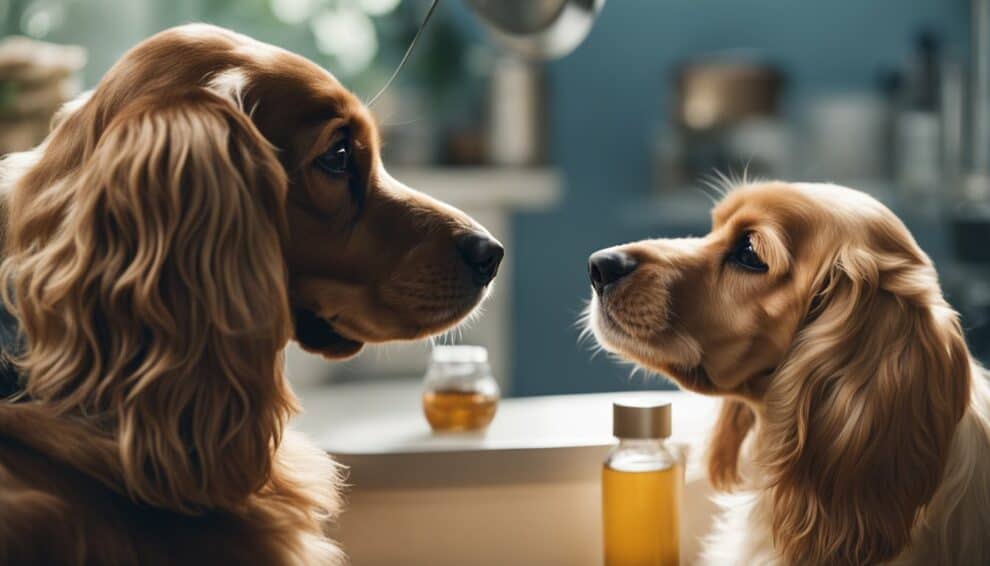Cocker Spaniels are beloved for their expressive eyes and soulful expressions, but their eye health can sometimes be a cause for concern.
Like all dogs, these affectionate companions are susceptible to developing cataracts, a condition characterized by the clouding of the lens within the eye.
This cloudiness can lead to a decrease in vision and, if left unchecked, potential blindness.
Owners of Cocker Spaniels should be vigilant in observing their pets for signs of cataracts, such as a noticeable opacity in the eye or changes in how their pet navigates familiar surroundings.

In addition to traditional veterinary care, holistic approaches have been gaining attention for maintaining and supporting eye health in Cocker Spaniels.
A focus on nutrition, for instance, with a diet rich in antioxidants can potentially help protect their eyesight.
Emerging studies suggest benefits from incorporating foods high in nutrients known to combat inflammation and oxidative stress, although more research is essential in this area.
As responsible pet owners, exploring natural strategies alongside conventional treatments offers a comprehensive plan for managing cataracts.
While a veterinary ophthalmologist’s expertise is crucial, especially regarding the decision for surgery, additional methods such as Decoding Signs of Cataracts can be valuable resources for pet parents.
It’s important to remember that every Cocker Spaniel is unique, and treatments should be as individualized as the care and love they receive at home.
Understanding Cataracts in Cocker Spaniels

Cataracts in Cocker Spaniels can significantly affect their quality of life.
This section focuses on the fundamental concept of cataracts in canines and the genetic components specific to Cocker Spaniels.
The Basics of Canine Cataracts
Cataracts are characterized by the clouding of the lens in a dog’s eye, leading to impaired vision and, in severe cases, blindness.
The lens of the eye is normally clear and functions to focus light on the retina.
With the development of cataracts, the lens becomes opaque, and light cannot reach the retina effectively, which can severely affect a dog’s vision.
Hereditary Factors in Cocker Spaniels
Cocker Spaniels are one of the breeds that have a genetic predisposition to cataracts, meaning that hereditary factors play a pivotal role in the development of the condition.
Research has shown that certain genes and genetic variants are associated with the higher incidence of inherited cataracts in this breed.
These hereditary cataracts are passed down from parents to their offspring, making genetics a crucial factor in breed health management.
Understanding the breed’s genetic predisposition allows for better breeding practices and early intervention strategies.
Identifying and Diagnosing Eye Conditions

When it comes to eye health in Cocker Spaniels, early detection of eye conditions, such as cataracts, is crucial.
Regular eye examinations are instrumental in preserving vision and should be a part of routine health check-ups.
Common Symptoms of Cataracts
Cocker Spaniels may exhibit several symptoms indicative of cataracts.
Owners might notice that their pet has a cloudy or bluish-gray appearance to their eyes.
This change in eye clarity often leads to a gradual decrease in vision, which may manifest as clumsiness or hesitation when navigating familiar environments.
In the early stages, the symptoms can be subtle and easily overlooked; therefore, it’s essential for Cocker Spaniels to undergo regular eye examinations, ideally at specialized eye clinics or by their veterinarian.
Professional Diagnosis by a Veterinary Ophthalmologist
A definitive diagnosis of cataracts in Cocker Spaniels requires a thorough examination by a veterinary ophthalmologist.
This typically involves a comprehensive evaluation that includes an ophthalmoscopy and a slit-lamp examination, both of which allow the ophthalmologist to visualize the interior of the eye and assess the health of the lens.
If a cataract is present, the lens will have opaque areas that impair the dog’s ability to see.
To ensure accurate diagnosis and care, owners are encouraged to seek evaluations from veterinary ophthalmologists who often have access to the most advanced diagnostic tools and have specialized training in identifying and treating eye conditions.
Treatment Options for Cataracts

When a Cocker Spaniel is diagnosed with cataracts, pet owners have a couple of paths they can consider: surgical or non-surgical management.
Both options come with their own set of considerations to support the health and comfort of their furry friend.
Surgical Intervention and Recovery
Cataract surgery, particularly phacoemulsification, is a common treatment for cataracts in dogs.
This procedure involves the use of ultrasound waves to break up the cloudy lens, which is then removed and often replaced with an artificial lens.
Post-surgery, dogs typically wear an Elizabethan collar to prevent them from scratching or rubbing their eyes during the recovery process.
- Before Surgery: It’s essential to get a thorough veterinary evaluation to ensure the dog is a suitable surgery candidate.
- After Surgery: Close monitoring and follow-up visits are critical for a successful recovery.
Recovery from cataract surgery usually involves several weeks of restricted activity, along with the administration of prescribed eye drops to reduce inflammation and prevent infection.
Patience and careful attention to the dog’s needs are key during this healing period.
Non-surgical Management and Support
For those opting out of surgery, non-surgical management includes the use of antioxidant-rich eye drops that may help to slow the progression of cataracts.
While these drops don’t reverse cataracts, they can support overall eye health.
- Nutritional Supplements: Incorporating antioxidants and Omega-3 fatty acids into the diet can support eye health.
- Environmental Adjustments: Keeping the living space well-lit and safe helps dogs with impaired vision navigate their surroundings.
Regular check-ups with a veterinarian are important to monitor the eyes and manage any changes in the condition.
A robust support system and slight lifestyle adjustments can help maintain a dog’s quality of life, even with cataracts.
Maintaining Eye Health and Preventing Disease

Cocker Spaniels can maintain eye health and prevent diseases like cataracts through consistent veterinary care and a diet fortified with specific nutrients.
Now, let’s look closer at how regular check-ups and proper nutrition contribute to their ocular well-being.
Importance of Regular Veterinary Care
Regular veterinary check-ups are crucial for early detection and prevention of eye diseases in Cocker Spaniels.
A veterinarian can conduct routine exams to monitor the dog’s ocular health over time, identifying any changes that may signify the onset of conditions like cataracts.
These examinations typically include an evaluation of the dog’s lens, which is where cataracts form.
Beyond detection, veterinarians can also advise on proactive measures to reduce the risk of eye-related issues.
Diet, Nutrition, and Supplements
A healthy diet plays a vital role in maintaining a Cocker Spaniel’s eye health.
Nutrients such as omega-3 fatty acids support cellular health, which is important for vision.
Including food rich in vitamin C can be beneficial, as it’s linked with a reduced risk of cataract formation.
Here’s a brief list of recommended nutrients and their sources:
- Omega-3 Fatty Acids: Found in fish like salmon and flaxseeds.
- Vitamin C: Abundant in fruits like oranges and vegetables like broccoli.
Incorporating a balanced blend of these nutrients through a mix of dog food and appropriate supplements can aid in preventing cataracts and maintaining overall eye health for Cocker Spaniels.
Owners should consult their veterinarian to tailor a nutrition plan specific to their dog’s needs.
Understanding Related Health Issues

When it comes to Cocker Spaniels with cataracts, it’s crucial to be aware of associated health problems that may arise.
Early detection and management can safeguard their quality of life.
Secondary Conditions and Complications
Glaucoma is a significant concern for Cocker Spaniels with cataracts.
This condition leads to increased pressure in the eye and can result in blindness if left untreated.
Uveitis, an inflammation of the eye’s middle layer, can also develop, further complicating the state of a Cocker Spaniel’s ocular health.
Diabetes mellitus is another health condition linked to cataract development; it necessitates careful monitoring as it can exacerbate eye problems.
- Glaucoma: Can lead to increased ocular pressure and potential blindness.
- Uveitis: Causes inflammation and can worsen cataract conditions.
- Diabetes Mellitus: Often associated with cataract formation; requires vigilant control to prevent further eye issues.
The Effects of Aging on Eye Health
As Cocker Spaniels grow older, their susceptibility to eye health issues like dry eye—a condition characterized by inadequate tear production—increases.
Dry eye can lead to discomfort and aggravate cataracts or other eye diseases.
The aging process naturally brings about changes in eye health, and awareness of this progression is essential for timely and effective interventions.
- Aging: Can cause changes leading to conditions like dry eye, which complicates existing issues.
- Old Age Complications: Monitoring and addressing eye health is critical as Cocker Spaniels advance in age.















